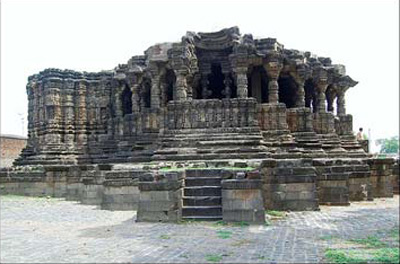Anwa Temple
Anwa Temple |
About: |
|
Anwa Temple is located 10 km away from Golegaon close to Aurangabad, Maharashtra. Presiding deity is Lord Shiva, and the temple dates back to 12th century. The temple has a sanctuary and a mandap (open hall) with decorated pillars. Anwa is a small village on the main road leading from Aurangabad to the Ajanta Caves. Anwa village gained significance because of Anwa Temple. The pillars of the temple has beautifully carved sculptures and bedecked pillars. The temple has also images of Vishnu, Ganesha and other divinities. |
Location info: |
| Address: Aurangabad,Maharashtra,India |
| District: Aurangabad District. |
| Nearest City:Aurangabad. |
| Best time to visit: Oct to Feb. |
Climate/Weather: |
| Temperate Climate with low relative humidity and diverse but not extreme weather conditions. |
History: |
Interesting things to do: |
|
Biwi-Ka-Maqbara: Lonar: Panchakki: |
Interesting things to Visit: |
|
Grishneshwar Temple is situated in the Verul village and is 11 kilometers from Daulatabad, which is near Aurangabad. It is one of the twelve Jyotirlingas (prominent temples) of Lord Shiva.Grishneshwar is also called as Ghushmeswara or Kusumeshwara. The temple is built from spotted red sandstone.There are sculptures of several Indian gods like Ganesh, Vishnu, Bhrama, Shiva and Parvati. Ajanta caves are a World Heritage site. These are cut on the rocky sides of a crescent-shaped gorge. Near the head, there is a waterfall that flows above the mountain rim. This waterfall flows over seven steps into a pool called as the Saptakund. The Ajanta caves date back to the 2nd century B.C. Inside the mountain, the Buddhist chaitya-vihara prayer and monastery caves can be seen. There are many murals that portray the life in ancient India. Ellora caves are also a World heritage Site. These were constructed between the fifth and eighth centuries A.D. There is a monolithic Kailasa temple, which is an architectural marvel. There is a Buddhist Vishvakarma chaitya and vihara. The Daulatabad Fort has several monuments like the Chini Mahal (Chinese Palace), the Elephant Tank, the Chand Minar and the Bharat Mata Mandir. The fort was the capital of the Delhi sultanate under Tughlaq. |
Mobile range info: |
How to reach? |
| Nearest Railway Station: Aurangabad. |
| Nearest Airport: Aurangabad railway Station. |
| Road Transport: One can also reach the city by a network of well maintained roads. There are several luxury and state run bus services that ply between Mumbai and Aurangabad. |
Nearest Visiting places: |
|
Pithalkora Caves: Elephanta Caves: Karla Caves: Bhaja Caves: |
Nearest Petrol Pump: |
| Available In Aurangabad district. |
Hotels/Lodge/Accommodation: |
|
Harpreet Hotels Business hotel Aurangabad Hotel & Resort |
Things to carry: |
Tips & Suggestions: |
Help Line/Phone Number: |
| Police Station: 100 |
|
Nearest Hospital: Kodlikeri Momorail Hospital Kamalnayan Bajaj Hospital Tirupati Hospital |
| Society/Community Phone Number |

.jpg)
.jpg)
.jpg)